Mineral Texture Identification Using Local Binary Patterns Equipped with a Classification and Recognition Updating System (CARUS)
Abstract
:1. Introduction
2. Typical Textures in Minerals
3. Brief Review of LBP
4. CARUS Algorithm for MI
4.1. Classification and Recognition
- (a)
- For an unknown mineral, an appropriate XPL image (usually the one with the maximum standard deviation (maxSD_Img)) from a set of rotated images is selected. This image is commonly expected to show typical textural features of a mineral.
- (b)
- The histogram (h) of its LBP image (LBP_Img) with nb bins is obtained (Equation (7)). Usually, nb is considered to be 100 × (P + 1), where P is the number of LBP samples as introduced in Section 3.
- (c)
- The h histogram of the LBP_Img is compared with those included in the h-db (a database of LBP image histograms of nt (i) typical samples for any mineral class i ≤ nc) through a distance metric gof, as introduced in Equation (5). Steps 1 through 5 of the TMI algorithm will provide a GOF matrix which incorporates the gof values corresponding to the h of the unknown mineral and those included in the h-db.
- (d)
- In steps 6 through 8, a mean function might be used, as shown in Figure 3, to develop a gof vector which specifies the gof values of the unknown mineral with any mineral classes included in h_db. The averaging scheme, as will be verified in Section 5, does have enough accuracy, increases robustness (in comparison with methods such as k-nearest neighbor (kNN)), and reduces the computational cost.
- (e)
- In steps 9 and 10, the minimum entry of gof is found, and its corresponding mineral class c is introduced as the one to which the unknown mineral belongs.
| Algorithm 1. Pseudo code for texture-based mineral identification algorithm (TMI). |
| Input: unknown mineral XPL image with standard deviation (maxSD_Img) Output: mineral class of the unknown mineral (c) Initialization: find from LBP image of unknown mineral image |

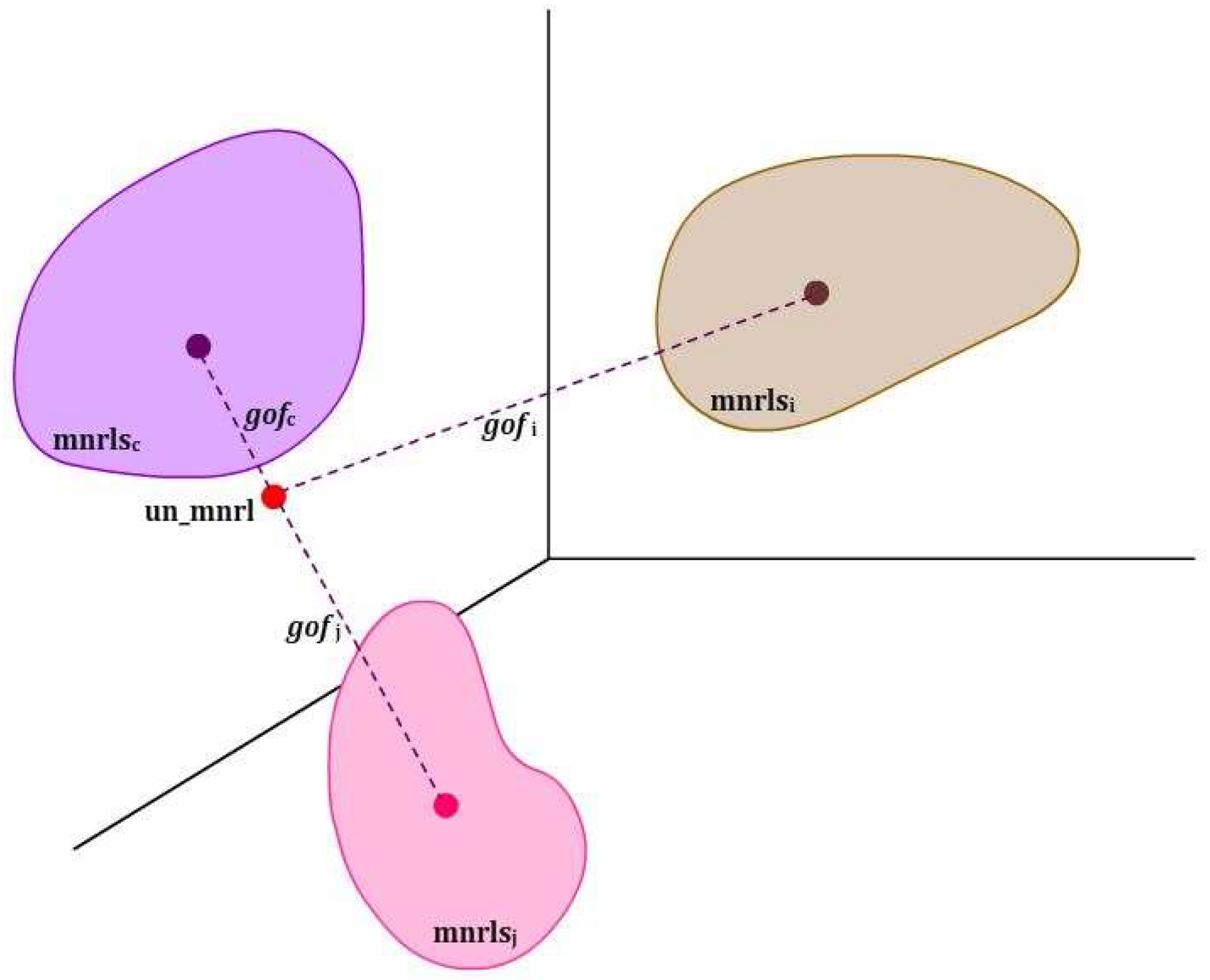
4.2. Updating System
- (a)
- An initial database of LBP histograms, h_db, obtained from an initial collection of some typical mineral samples, is established. In developing such a dataset, mineral images must be selected such that they can well represent different types of structural and non-structural conditions. While structural conditions (S factors) pertain to both the genesis of the mineral (S-I factors) and the environmental conditions such as temperature, pressure, and hydrothermal solution (S-II factors) that cause different degrees of alteration, the non-structural ones (NS factors) are mostly related to laboratory and equipment conditions (e.g., microscopes and digital cameras with different qualities, lighting changes, different magnification in microscopy, different orientations, etc.). It will be shown that a poor initial database may deteriorate the performance of the developed database.
- (b)
- A GOFc matrix, incorporating all gof values obtained for the sample minerals of the h_db belonging to the cth mineral class, is established (steps 1 through 5).
- (c)
- Mean gof values for each sample of the mineral class c are calculated, which gives the vector gofc (steps 6 through 8); a gofc_s vector is obtained by sorting gofc in descending order (step 9).
- (d)
- In steps 10 through 14, the HDU algorithm decides whether to add the LBP histogram of the identified mineral sample (in the previous TMI run) to h_db or not. For this purpose, the two following conditions are investigated:
- (1)
- gof value of the identified sample must be less than gofc_s(1) which is the maximum entry of the gofc vector. The condition is schematically illustrated in Figure 5a. LBP histograms of mineral instances in class c, mnrlsc, are within an acceptance circle C1max with the radius of gofc_s(1) (the center of the circle is a virtual point and is depicted for geometric interpretation). As the first condition, the identified mineral, un_mnrl, must be located within the acceptance circle of mnrlsc.
- (2)
- gofc_s(1) is checked for being less than all gof values of the gof vector (other than gof =gof(c)); it is reminded that gof is obtained in steps 6–8 of the TMI algorithm (refer to Algorithm 1 (and Figure 3)). The geometric interpretation of this criterion is illustrated in Figure 5a, where the mean virtual points of all mineral classes (except c) are located out of the dashed circle C’max (a circle with the center point of un-mnrl, and the same radius as C1max). If this condition is satisfied, an LBP histogram of the identified sample h is added to h_db. Otherwise, the next entry of gofc_s, i.e., the next maximum value of gofc, is examined for this criterion. This loop is continued until both conditions are satisfied. Figure 5b illustrates a situation where the second criterion is not satisfied (i.e., both virtual centers of mnrlsc and mnrlsj classes are within the light dashed circle), but by selecting the kth maximum entry of gofc_s, a circle C’max (with the same radius as Ckmax) is introduced for which centers of mnrlsc and mnrlsj are, respectively, within and out of it. There might be cases for which such reduction in the acceptance circle may fail the first condition (i.e., the identified mineral, un_mnrl, located out of the acceptance circle (C’max) of mnrlsc); thus, the mineral will not be added to the database.
| Algorithm 2. Pseudo code for h-db update algorithm (HDU). |
| Input: Output: |
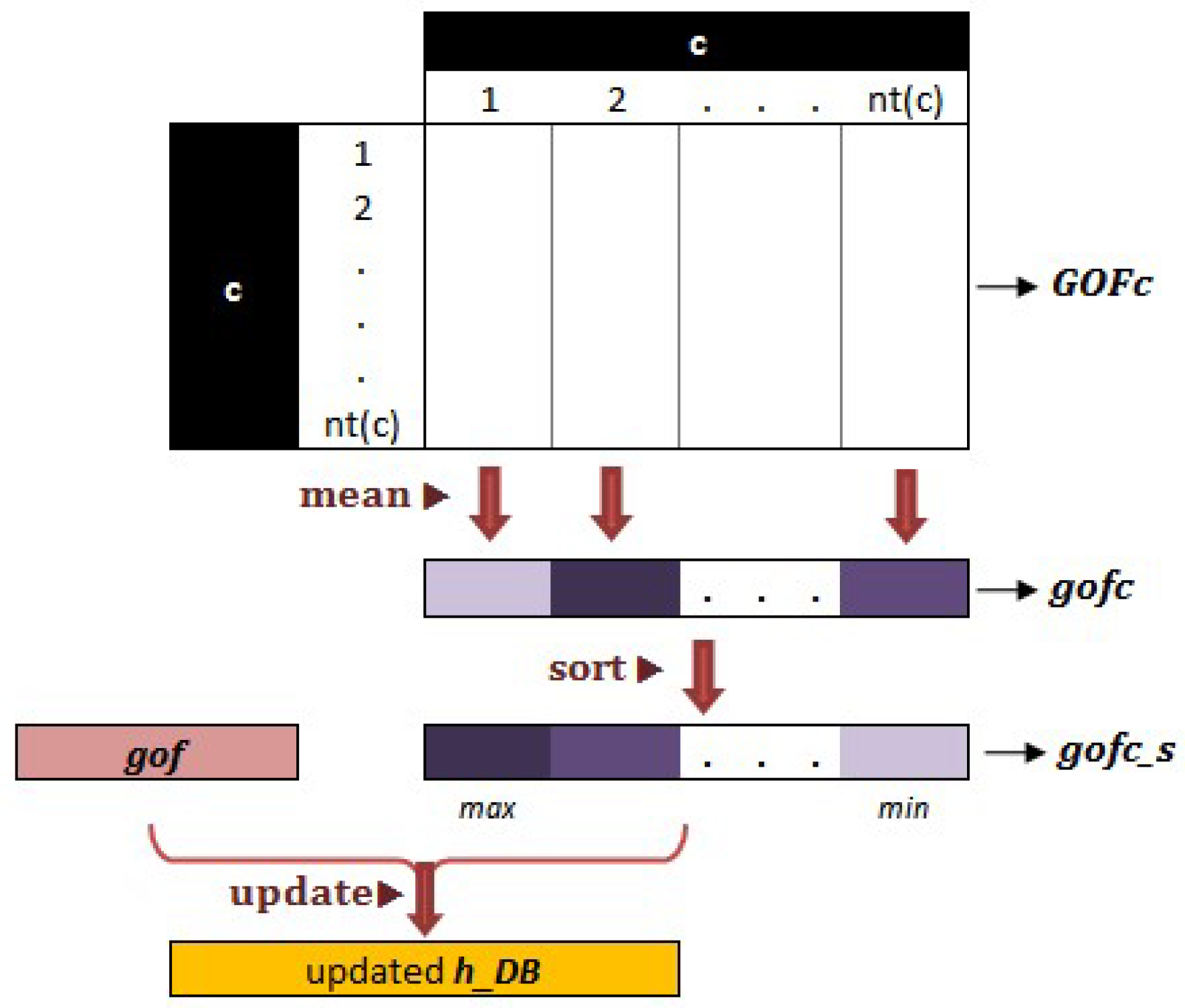
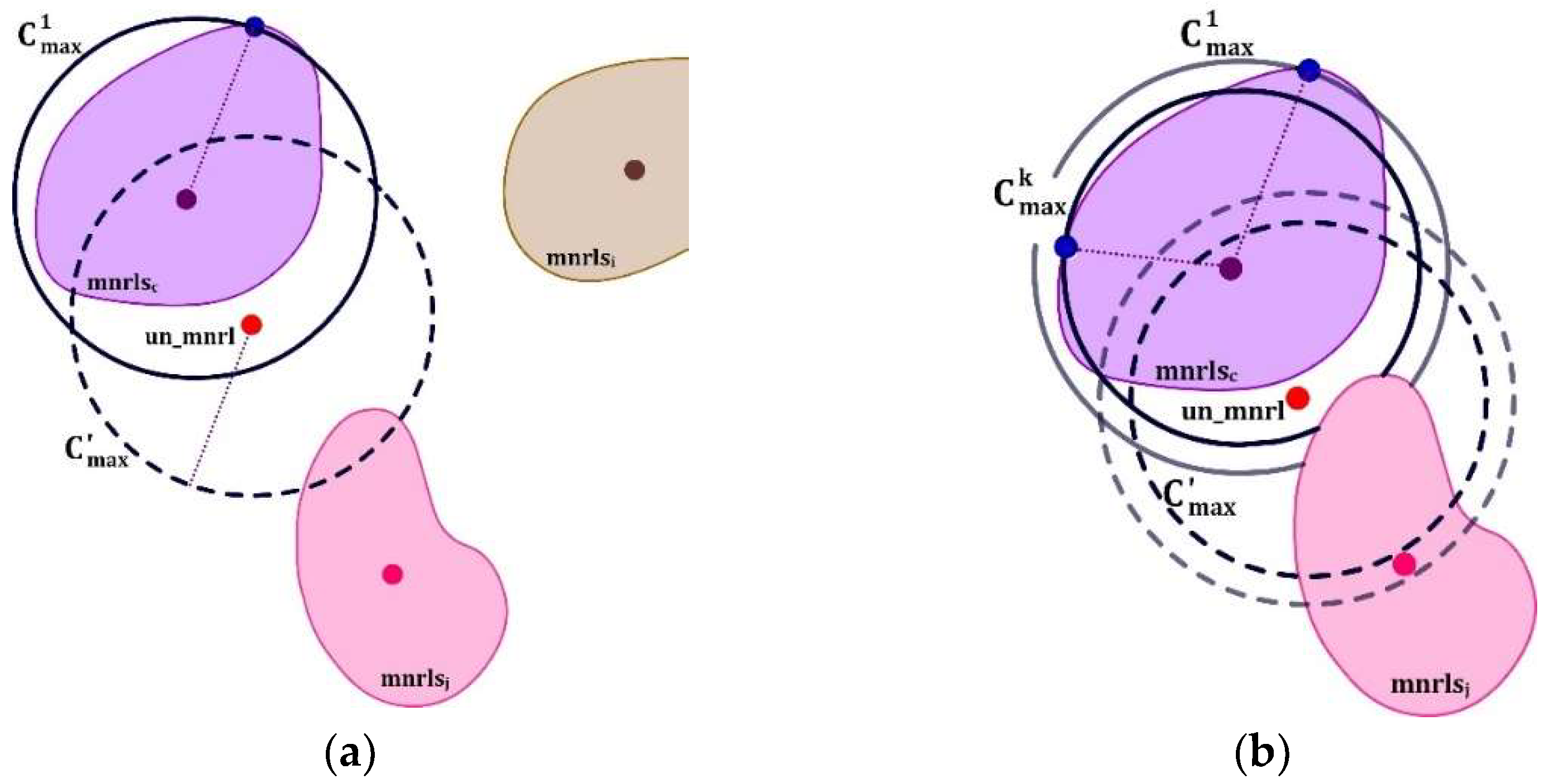
5. Experiments and Results
5.1. Comparison of LBPs for TMI
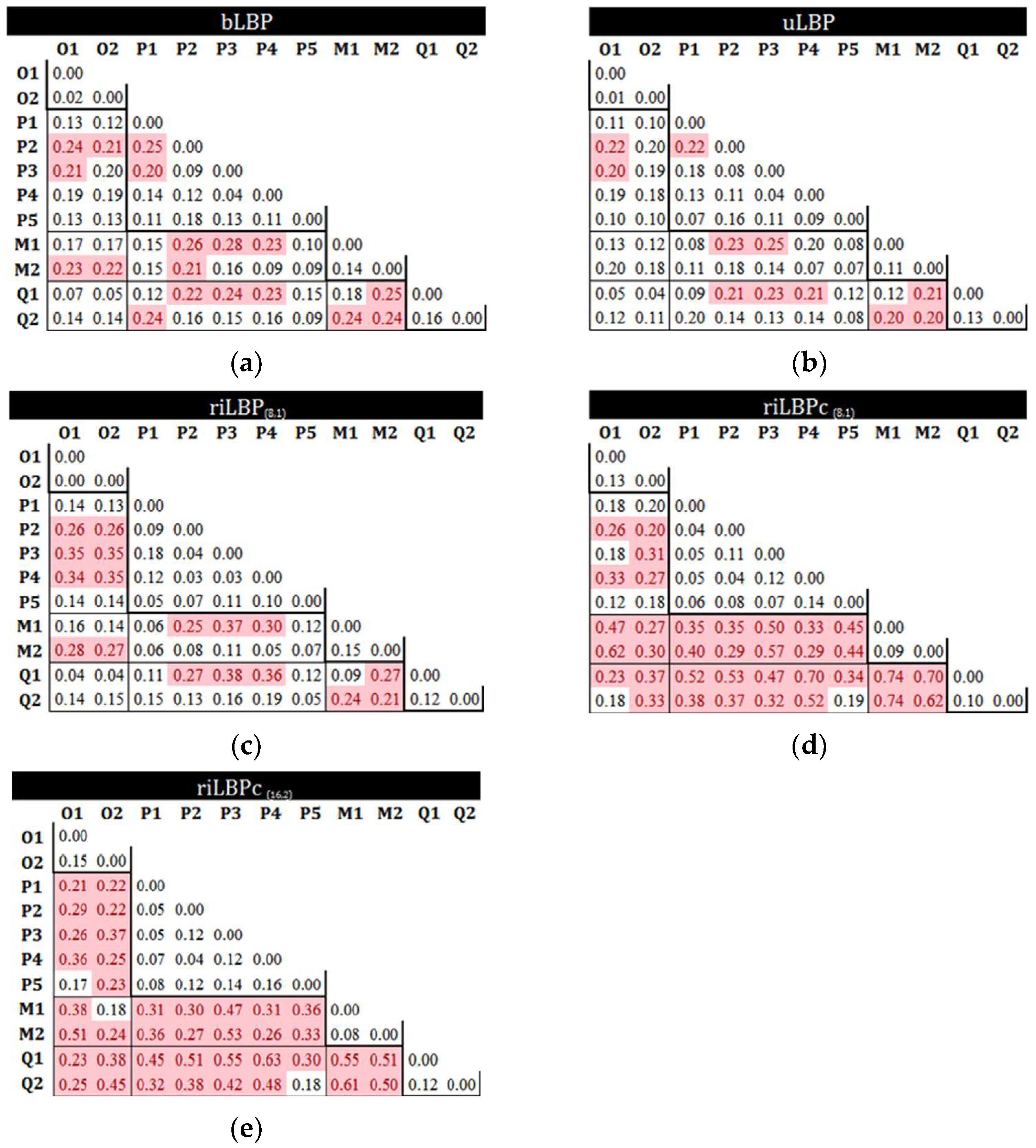
5.2. Comparison of LBP with GLCM
5.3. CARUS Algorithm Validation
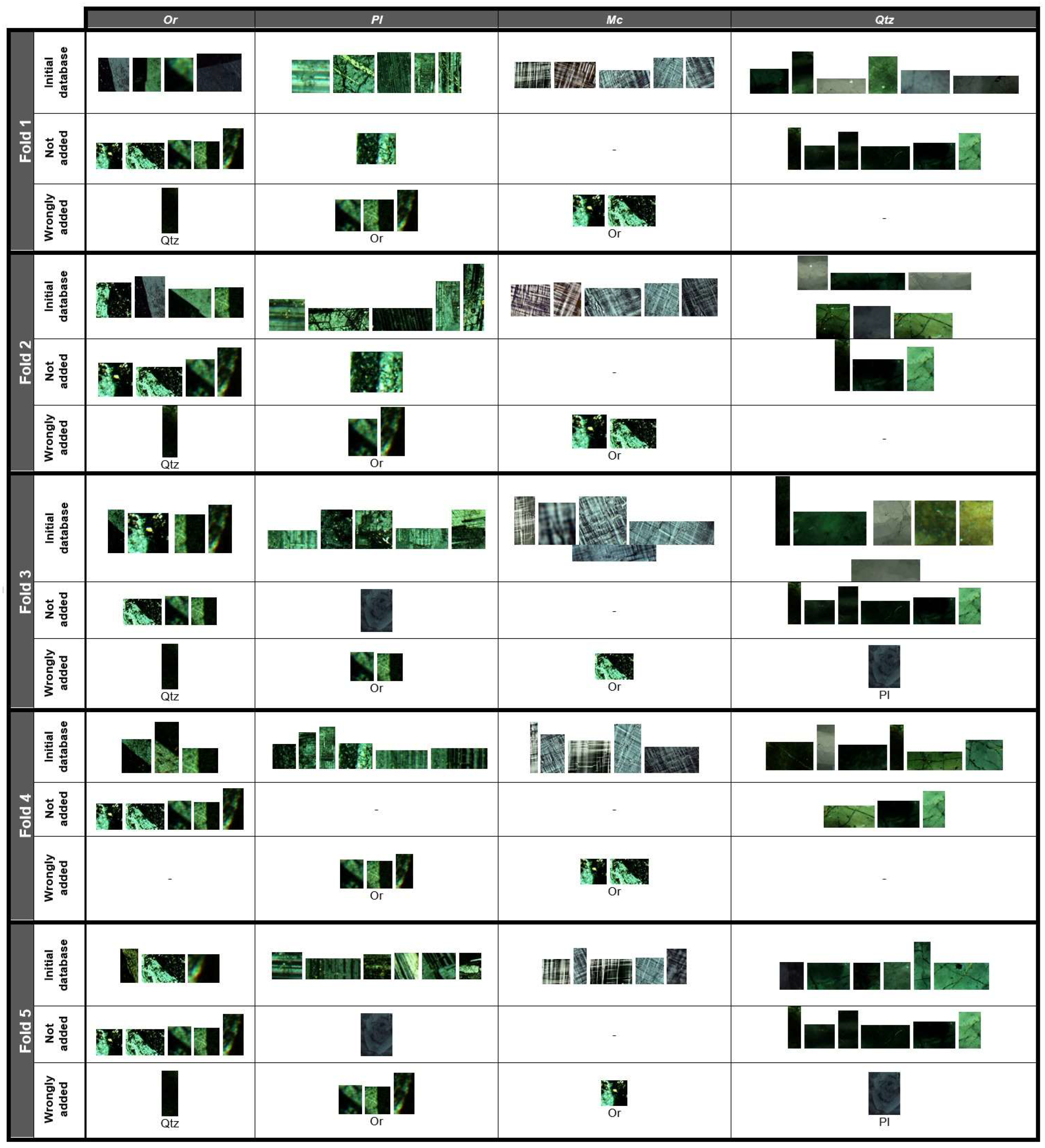
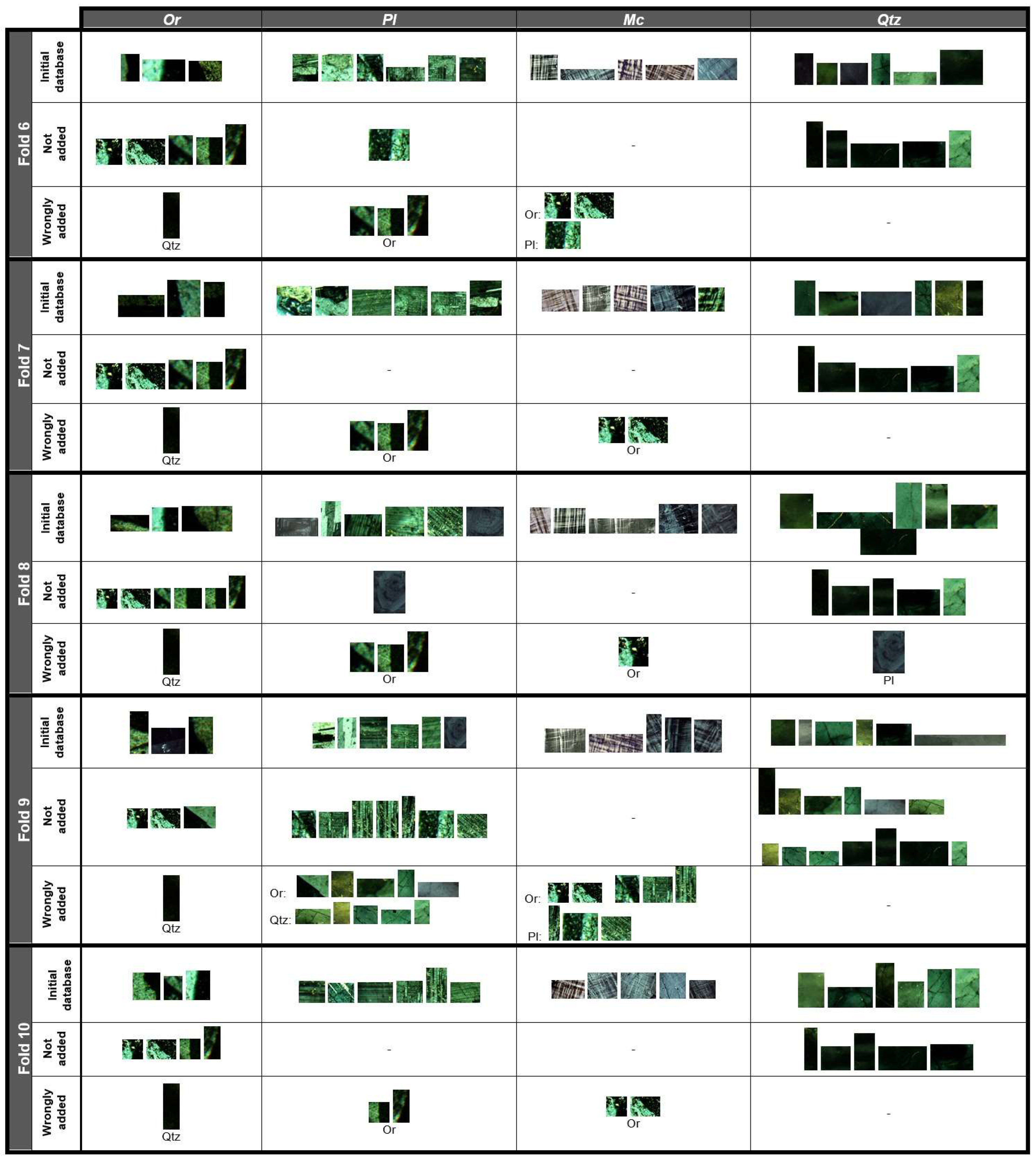
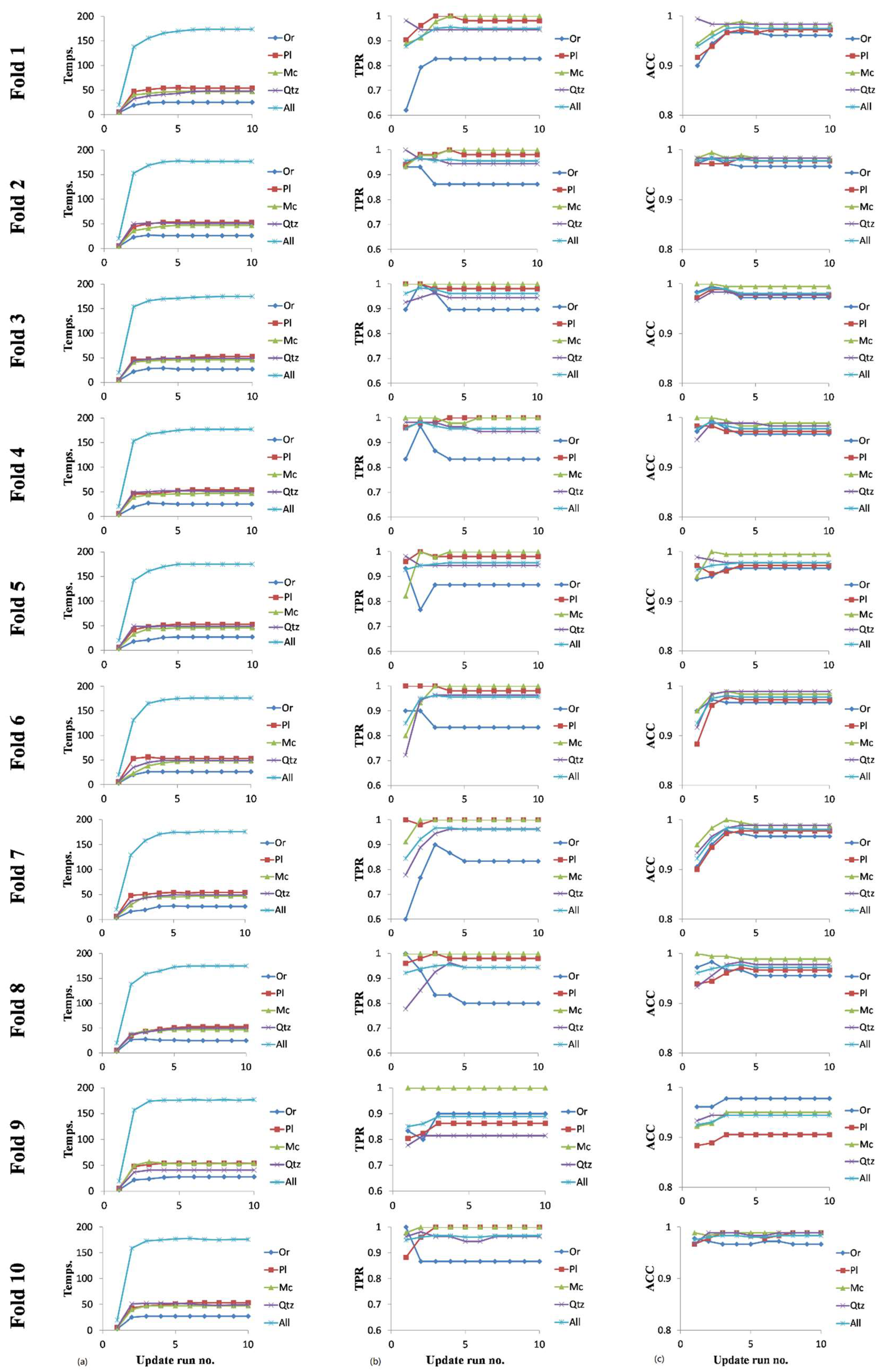

5.4. Comparison of CARUS Classification Method with kNN
6. Limitations and Future Work
7. Conclusions
- Texture feature selection: For mineral texture identification, noise and rotation are two main problems, and contrast has a key role in better recognition; thus, an LBP operator benefits from contrast and reduces the negative effects of noise and rotation is of much interest. The rotation-invariant local binary patterns, equipped with a complementary contrast measure, are proved to be a well-performing option for this purpose. It was shown that the selected rotation-invariant LBP can effectively outperform other texture features, such as GLCM, in the MI problem.
- Classification algorithm: Mineral textures might be affected by structural and non-structural conditions; so, for reliable and robust TMI automation, a reasonable flexible classification algorithm is required. Here, in this study, a new classification scheme was designed based on mean distances between the LBP histogram of the unknown mineral with those belonging to a mineral class. The TMI results showed accuracies above 95% and proved to be better than the well-known kNN classification scheme, especially when an initial well-adjusted mineral database is provided.
- Database updating procedure: Since no standard mineral texture database is available in the mineralogy community, an updating procedure was designed to improve any local initial database. The updating procedure incorporates newly identified minerals in the database if they satisfy certain criteria. Since during the TMI procedure, some minerals might falsely be recognized and located in the database, iterative runs of the updating algorithm will stabilize the LBP histogram database. Thus, the proposed updating procedure can automatically extend initial databases and produce efficient and rich mineral texture databases. It is notable that the update algorithm automatically removed samples that have high differences from samples in a certain class.
Author Contributions
Funding
Institutional Review Board Statement
Informed Consent Statement
Data Availability Statement
Conflicts of Interest
References
- Autio, J.; Lepisto, L.; Visa, A. Image analysis and data mining in rock material research. Materia 2004, 4, 36–40. [Google Scholar]
- Asmussen, P.; Conrad, O.; Günther, A.; Kirsch, M.; Riller, U. Semi-automatic segmentation of petrographic thin section images using a “seeded-region growing algorithm” with an application to characterize wheathered subarkose sandstone. Comput. Geosci. 2015, 83, 89–99. [Google Scholar] [CrossRef]
- Filho, I.M.; Spina, T.V.; Falcao, A.X.; Vidal, A.C. Segmentation of sandstone thin section images with separation of touching grains using optimum path fores operators. Comput. Geosci. 2013, 57, 146–157. [Google Scholar] [CrossRef]
- Marschallinger, R.; Hofmann, P. The application of object based image analysis to petrographic micrographs. Microsc. Sci. Technol. Appl. Educ. 2010, 4, 1526–1532. [Google Scholar]
- Mlynarczuk, M.; Gorszczyk, A.; Slipek, B. The application of pattern recognition in the automatic classification of microscopic rock images. Comput. Geosci. 2013, 60, 126–133. [Google Scholar] [CrossRef]
- Lawal, M.O. Tomato detection based on modified YOLOv3 framework. Sci. Rep. 2021, 11, 1447. [Google Scholar] [CrossRef] [PubMed]
- Huizhen, H.; Zhiwei, J.; Shipping, G.; Cong, W.; Qing, G. Siamese Adversarial Network for image classification of heavy mineral grains. Comput. Geosci. 2022, 159, 105016. [Google Scholar]
- Fueten, F.; Mason, J. An artificial neural net assisted approach to editing edges in petrographic images collected with the rotation polarizer stage. Comput. Geosci. 2007, 33, 1176–1188. [Google Scholar] [CrossRef]
- Changyu, J.; Kai, W.; Tao, H.; Yu, L.; Aixin, L.; Dong, L. Segmentation of ore and waste rocks in borehole images using the multi-module densely connected U-net. Comput. Geosci. 2022, 159, 105018. [Google Scholar]
- Ge, S.; Wang, C.; Jiang, Z.W.; Hao, H.Z.; Gu, Q. Dual-input attention network for automatic identification of detritus from river sands. Comput. Geosci. 2021, 151, 104735. [Google Scholar] [CrossRef]
- Prikryl, R. Assessment of rock geomechanical quality by quantitative rock fabric coefficients: Limitations and possible source of misinterpretations. Eng. Geol. 2006, 87, 149–162. [Google Scholar] [CrossRef]
- Tandon, S.R.; Gupta, V. The control of mineral constituents and textural characteristics on the petrophysical & mechanical (PM) properties of different rocks of the Himalaya. Eng. Geol. 2013, 153, 125–143. [Google Scholar]
- Yilmaz, N.G.; Goktan, R.M.; Kibici, Y. Relation between some quantitative petrographic characteristics and mechanical strength properties of granitic building stones. Int. J. Rock Mech. Min. Sci. 2011, 48, 506–513. [Google Scholar] [CrossRef]
- Aligholi, S.; Lashkaripour, G.R.; Ghafoori, M.; TrighAzali, S. Evaluating the relationships between NTNU/SINTEF drillability indices with index properties and petrographic data of hard igneous rocks. Rock Mech. Rock Eng. 2017, 50, 2929–2953. [Google Scholar] [CrossRef]
- Aligholi, S.; Lashkaripour, G.R.; Ghafoori, M. Estimating engineering properties of igneous rocks using semi-automatic petro-graphic analysis. Bull. Eng. Geol. Environ. 2019, 78, 2299–2314. [Google Scholar] [CrossRef]
- Aligholi, S.; Khajavi, R.; Razmara, M. Automated mineral identification algorithm using optical properties of crystals. Comput. Geosci. 2015, 85, 175–183. [Google Scholar] [CrossRef]
- Aligholi, S.; Lashkaripour, G.R.; Khajavi, R.; Razmara, M. Automatic mineral identification using color tracking. Pattern Recognit. 2017, 65, 164–174. [Google Scholar] [CrossRef]
- Naseri, A.; Rezaei Nasab, A. Automatic identification of minerals in thin sections using image processing. J. Ambient Intell. Humaniz. Comput. 2021, 1–13. [Google Scholar] [CrossRef]
- Zeng, X.; Xiao, Y.; Ji, X.; Wang, G. Mineral Identification Based on Deep Learning That Combines Image and Mohs Hardness. Minerals 2021, 11, 506. [Google Scholar] [CrossRef]
- Ross, B.J.; Fueten, F.; Yashkir, D.Y. Automatic mineral identification using genetic programming. Mach. Vis. Appl. 2001, 13, 61–69. [Google Scholar] [CrossRef]
- Thompson, S.; Fueten, F.; Bockus, D. Mineral identification using artificial neural networks and the rotating polarizer stage. Comput. Geosci. 2001, 27, 1081–1089. [Google Scholar] [CrossRef]
- Backes, A.R.; Casanova, D.; Bruno, O.M. Color texture analysis based on fractal descriptors. Pattern Recognit. 2012, 45, 1984–1992. [Google Scholar] [CrossRef]
- Tuceryan, M.; Jain, A.K. Texture Analysis in Handbook of Pattern Recognition and Image Processing; World Scientific: Singapore, 1993. [Google Scholar]
- Ji, Q.; Engel, J.; Craine, E. Texture analysis for classification of cervix lesions. IEEE Trans. Med. Imaging 2000, 19, 1144–1149. [Google Scholar] [CrossRef] [PubMed]
- Cohen, F.S.; Fan, Z.; Attali, S. Automated inspection of textile fabrics using textural models. IEEE Trans. Pattern Anal. Mach. Intell. 1991, 13, 803–808. [Google Scholar] [CrossRef]
- Anys, H.; He, D.C. Evaluation of textural and multipolarization radar features for crop classification. IEEE Trans. Geosci. Remote Sens. 1995, 33, 1170–1181. [Google Scholar] [CrossRef]
- Haralick, R.M.; Shanmugam, K.; Dinstein, I. Textural features for image classification. IEEE Trans. Syst. Man Cy. 1973, 3, 610–621. [Google Scholar] [CrossRef]
- Petrou, M.; Sevilla, P.G. Image Processing Dealing with Texture; John Wiley & Sons: Hoboken, NJ, USA, 2006. [Google Scholar]
- Davis, I.S. Polarograms: A new tool for Image Texture Analysis. Pattern Recognit. 1981, 13, 219–223. [Google Scholar] [CrossRef]
- Chen, M.Y.; Kundu, A. A complemment to variable duration hidden Markov model in handwritten word recognition. In Proceedings of the IEEE International Conference on Image Processing, 1994 (ICIP-94), Austin, TX, USA, 13–16 November 1994; Volume 1, pp. 174–178. [Google Scholar]
- Azencott, R.; Wang, J.P.; Younes, L. Texture classification using windowed fourier filters. IEEE Trans. Pattern Anal. Mach. Intell. 1997, 19, 148–153. [Google Scholar] [CrossRef]
- Randen, T.; Husoy, J.H. Filtering for texture classification: A comparative study. IEEE Trans. Pattern Anal. Mach. Intell. 1999, 21, 291–310. [Google Scholar] [CrossRef]
- Unser, M. Texture classification and segmentation using wavelet frames. IEEE Trans. Image Process. 1995, 4, 1549–1560. [Google Scholar] [CrossRef]
- Ojala, T.; Pietikäinen, M.; Mäenpää, T. Multiresolution gray-scale and rotation invariant texture classification with local binary patterns. IEEE Trans. Pattern Anal. Mach. Intell. 2002, 24, 971–987. [Google Scholar] [CrossRef]
- Ahonen, T.; Hadid, A.; Pietikainen, M. Face description with local binary patterns: Application to face recognition. IEEE Trans. Pattern Anal. Mach. Intell. 2006, 28, 2037–2041. [Google Scholar] [CrossRef] [PubMed]
- Bereta, M.; Karczmarek, P.; Pedrycz, W.; Reformat, M. Local descriptors in application to the aging problem in face recognition. Pattern Recognit. 2013, 46, 2634–2646. [Google Scholar] [CrossRef]
- Guo, Z.; Zhang, L.; Zhang, D. A completed modeling of local binary pattern operator for texture classification. IEEE Trans. Image Process. 2010, 19, 1657–1663. [Google Scholar]
- Hadid, A.; Pietikäinen, M. Combining appearance and motion for face and gender recognition from videos. Pattern Recognit. 2009, 42, 2818–2827. [Google Scholar] [CrossRef]
- Mehta, R.; Yuan, J.; Egiazarian, K. Face recognition using scale-adaptive directional and textural features. Pattern Recognit. 2014, 47, 1846–1858. [Google Scholar] [CrossRef]
- Nanni, L.; Lumini, A.; Brahnam, S. Survey on LBP based texture descriptors for image classification. Expert Syst. Appl. 2012, 39, 3634–3641. [Google Scholar] [CrossRef]
- Satpathy, A.; Jiang, X.; Eng, H.L. LBP based edge-texture features for object recognition. IEEE Trans. Image Process. 2014, 23, 1953–1964. [Google Scholar] [CrossRef]
- Song, C.; Yang, F.; Li, P. Rotation invariant texture measured by local binary pattern for remote sensing image classification. In Proceedings of the Second International Workshop on Education Technology and Computer Science, Wuhan, China, 6–7 March 2010. [Google Scholar]
- Vatsavai, R.R.; Cheriyadat, A.; Gleason, S. Unsupervised semantic labeling framework for identification of complex facilities in high-resolution remote sensing images. In Proceedings of the Data Mining Workshops (ICDMW), Sydney, Australia, 13 December 2010. [Google Scholar]
- Wu, J.; Rehg, J. Centrist: A visual descriptor for scene categorization. IEEE Trans. Pattern Anal. Mach. Intell. 2011, 33, 1489–1501. [Google Scholar]
- Zhao, G.; Pietikainen, M. Dynamic texture recognition using local binary patterns with an application to facial expressions. IEEE Trans. Pattern Anal. Mach. Intell. 2007, 29, 915–928. [Google Scholar] [CrossRef]
- Liao, S.; Chung, A. Face recognition by using elongated local binary patterns with average maximum distance gradient magnitude. In Proceedings of the Computer Vision—ACCV 2007, Tokyo, Japan, 18–22 November 2007; pp. 672–679. [Google Scholar]
- Guo, Z.; Zhang, L.; Zhang, D. Rotation invariant texture classification using lbp variance with global matching. Pattern Recognit. 2010, 43, 706–719. [Google Scholar] [CrossRef]
- Qi, X.; Xiao, R.; Guo, J.; Zhang, L. Pairwise rotation invariant co-occurrence local binary pattern. In Proceedings of the Computer Vision–ECCV 2012, Florence, Italy, 7–13 October 2012; pp. 158–171. [Google Scholar]
- Zhu, Z.; You, X.; Chen, C.L.P.; Tao, D.; Ou, W.; Zou, J. An adaptive hybrid pattern for noise-robust texture analysis. Pattern Recognit. 2015, 48, 2592–2608. [Google Scholar] [CrossRef]
- Smith, J.V.; Beermann, E. Image analysis of plagioclase crystals in rock thin sections using grey level homogeneity recognition of discrete areas. Comput. Geosci. 2007, 33, 335–356. [Google Scholar] [CrossRef]
- Pettijohn, F.J.; Potter, P.E.; Siever, R. Sand and Sandstone; Springer: Berlin/Heidelberg, Germany, 1987. [Google Scholar]
- Streckeisen, A.L. To each plutonic rock its proper name. Earth Sci. Rev. 1976, 12, 12–33. [Google Scholar] [CrossRef]
- Klein, C. Manual of Mineralogy, 22nd ed.; Wiley: Hoboken, NJ, USA, 2001. [Google Scholar]
- Deer, W.A.; Howie, R.A.; Zusman, J. Rock Forming Minerals; Longman: New York, NY, USA, 1996. [Google Scholar]
- Gribble, C.D.; Hall, A.J. A Practical Introduction to Optical Mineralogy; George Allen & Unwin: London, UK, 1985. [Google Scholar]
- Ojala, T.; Pietikäinen, M.; Harwood, D. A comparative study of texture measures with classification based on feature distributions. Pattern Recognit. 1996, 29, 51–59. [Google Scholar] [CrossRef]
- Ojala, T.; Pietikäinen, M.; Mäenpää, T. Gray scale and rotation invariant texture classification with local binary patterns. In Proceedings of the European Conference on Computer Vision. Lecture Notes in Computer Science, Dublin, Ireland, 26 June–1 July 2000; Springer: Berlin/Heidelberg, Germany, 2000; Volume 1842. [Google Scholar]
- Pietikäinen, M.; Zhao, G.; Hadid, A.; Ahonen, T. Computer Vision Using Local Binary Patterns; Springer: Berlin/Heidelberg, Germany, 2011. [Google Scholar]
- Mäenpää, T.; Ojala, T.; Pietikäinen, M.; Soriano, M. Robust texture classification by subsets of local binary patterns. In Proceedings of the 15th International Conference on Pattern Recognition, Barcelona, Spain, 3–7 September 2000. [Google Scholar]
- Soh, L.K.; Tsatsoulis, C. Texture analysis of SAR sea ice imagery using gray level co-occurrence matrices. IEEE Trans. Geosci. Remote Sens. 1999, 37, 780–795. [Google Scholar] [CrossRef] [Green Version]
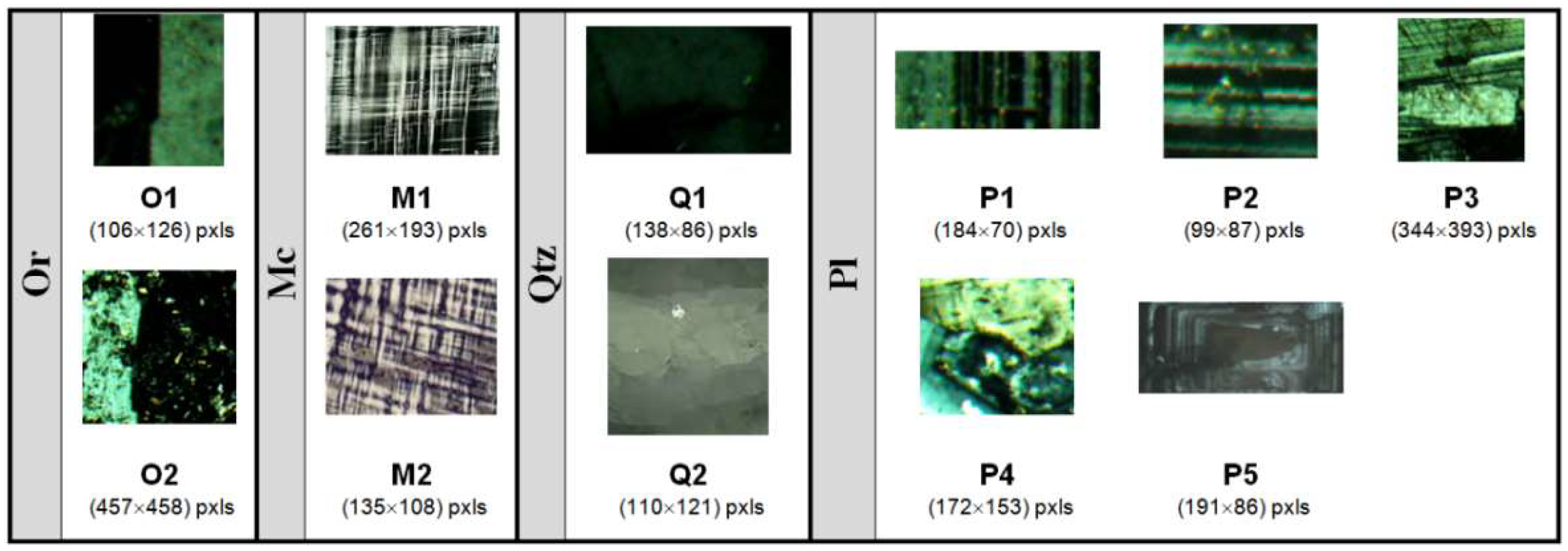
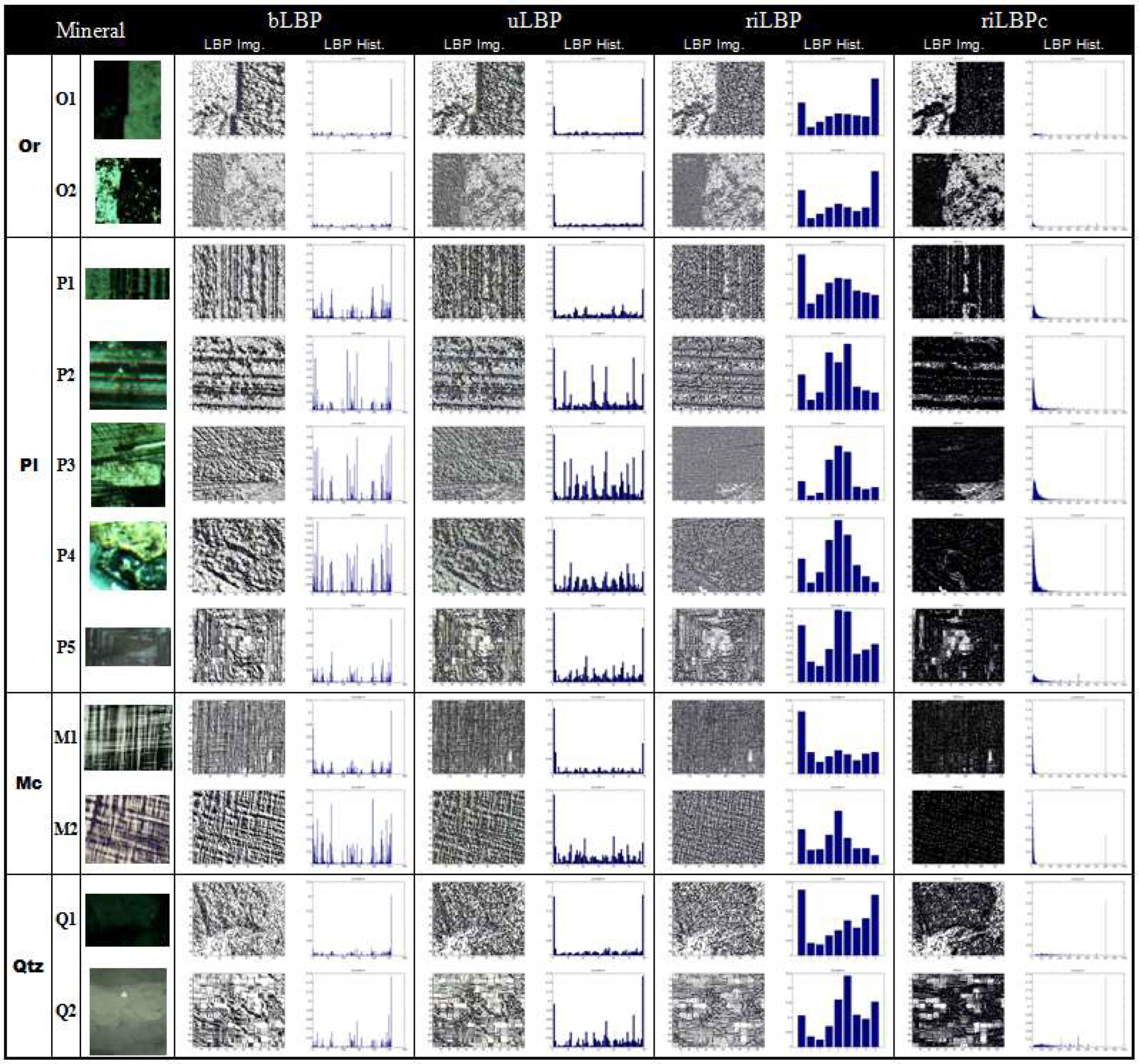
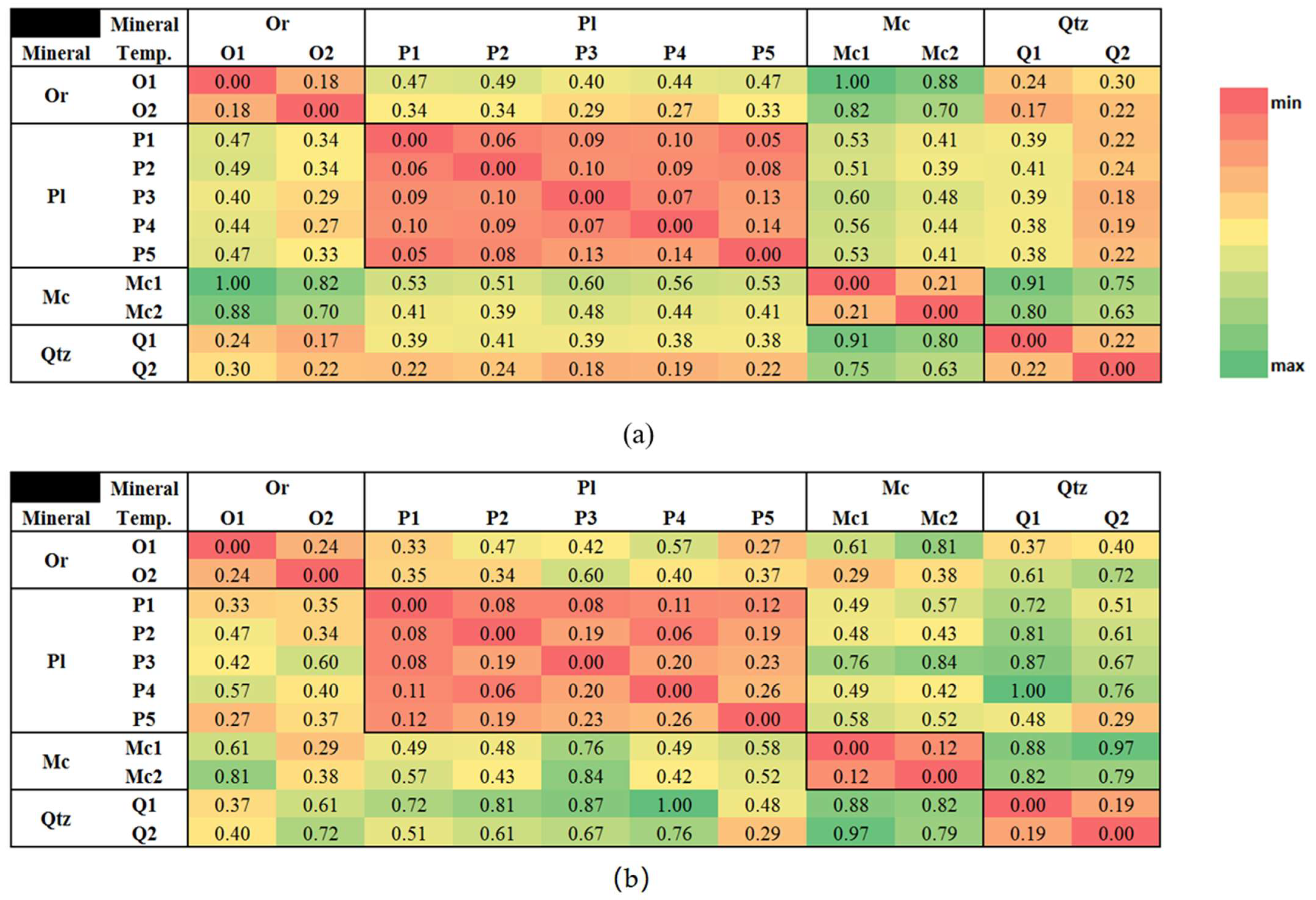
| Method | Discriminatory Power |
|---|---|
| bLBP | 0.61 |
| uLBP | 0.645 |
| riLBP(8,1) | 0.745 |
| riLBPc(8,1) | 0.82 |
| riLBPc(16,2) | 0.825 |
| GLCM1 | 0.75 |
| GLCM2 | 0.77 |
| Method | Discriminatory Power |
|---|---|
| kNN | 0.825 |
| CARUS (before updating) | 0.91 |
| TPR | |
| CARUS (before updating) | 0.955 |
| ACC | |
| CARUS (after updating) | 0.95 |
| TPR | |
| CARUS (after updating) | 0.975 |
| ACC |
Publisher’s Note: MDPI stays neutral with regard to jurisdictional claims in published maps and institutional affiliations. |
© 2022 by the authors. Licensee MDPI, Basel, Switzerland. This article is an open access article distributed under the terms and conditions of the Creative Commons Attribution (CC BY) license (https://creativecommons.org/licenses/by/4.0/).
Share and Cite
Aligholi, S.; Khajavi, R.; Khandelwal, M.; Armaghani, D.J. Mineral Texture Identification Using Local Binary Patterns Equipped with a Classification and Recognition Updating System (CARUS). Sustainability 2022, 14, 11291. https://doi.org/10.3390/su141811291
Aligholi S, Khajavi R, Khandelwal M, Armaghani DJ. Mineral Texture Identification Using Local Binary Patterns Equipped with a Classification and Recognition Updating System (CARUS). Sustainability. 2022; 14(18):11291. https://doi.org/10.3390/su141811291
Chicago/Turabian StyleAligholi, Saeed, Reza Khajavi, Manoj Khandelwal, and Danial Jahed Armaghani. 2022. "Mineral Texture Identification Using Local Binary Patterns Equipped with a Classification and Recognition Updating System (CARUS)" Sustainability 14, no. 18: 11291. https://doi.org/10.3390/su141811291
APA StyleAligholi, S., Khajavi, R., Khandelwal, M., & Armaghani, D. J. (2022). Mineral Texture Identification Using Local Binary Patterns Equipped with a Classification and Recognition Updating System (CARUS). Sustainability, 14(18), 11291. https://doi.org/10.3390/su141811291









